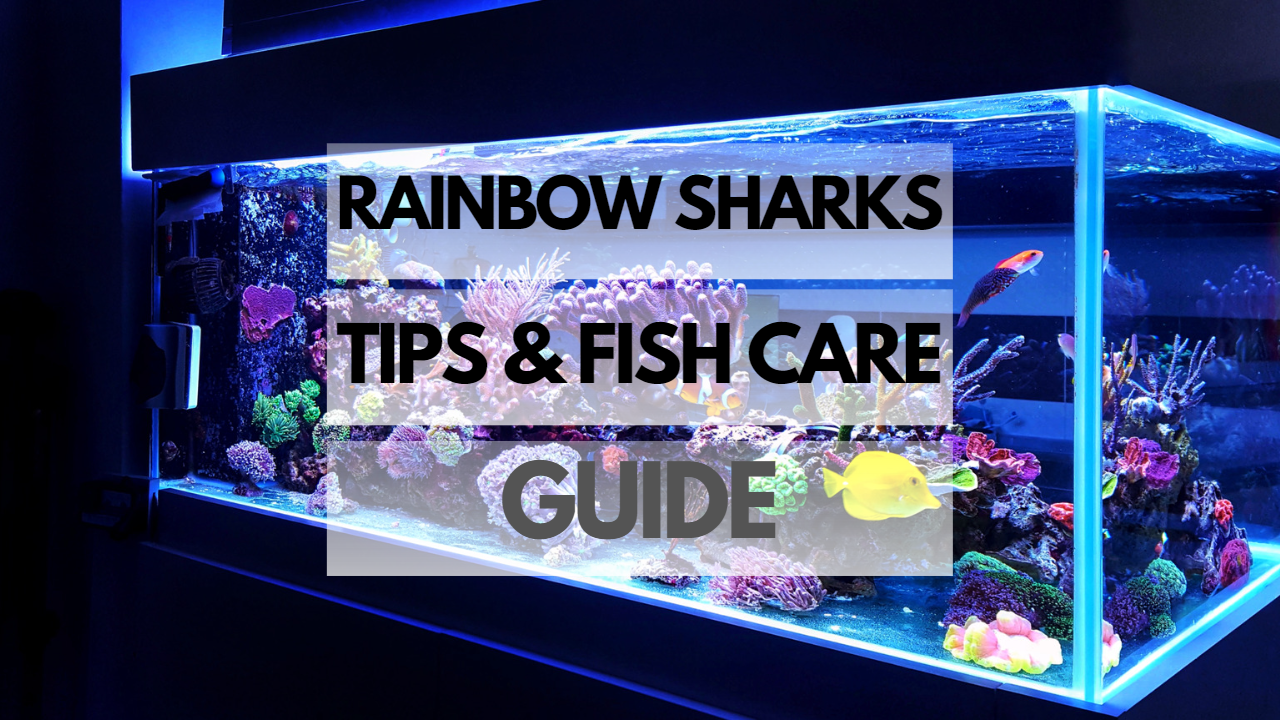Rainbow Sharks are fascinating fish that can add a splash of color and a unique presence to any aquarium. In this comprehensive guide, we’ll cover everything you need to know about keeping Rainbow Sharks as pets, from their habitat and tank setup to their diet and maintenance requirements.
Quick Reference Table: Rainbow Shark Facts
| Fact | Details |
|---|---|
| Scientific Classification | Epalzeorhynchos frenatum |
| Ease of Care | Moderate |
| Lifespan | 5-8 years |
| Color Variations | Gray to black body with red fins |
| Size | Up to 6 inches (15 cm) |
| Tank Size | Minimum 55 gallons |
| Water Temperature | 72-79°F (22-26°C) |
| Food | Omnivorous: high-quality pellets or flakes, live and frozen foods, vegetables |
| Can Survive in Bowls | No |
| Requires Filter | Yes |
| Requires Heater | Yes |
How Are Rainbow Sharks as Pets?
Rainbow Sharks are striking and active pets that can be rewarding for experienced fishkeepers. While they are territorial and can be aggressive towards other bottom-dwelling fish, they generally coexist well with peaceful, fast-swimming tank mates, making them a captivating addition to community aquariums.
Are Rainbow Sharks Easy to Care For?
Rainbow Sharks have moderate care requirements, making them suitable for intermediate fishkeepers. They need a large, well-maintained tank with hiding spots and clean water. They can be sensitive to water quality, so regular maintenance and monitoring are essential for their well-being.
Pros and Cons of Rainbow Sharks
| Pros | Cons |
|---|---|
| Striking appearance | Can be territorial and aggressive |
| Active swimmers | Require a large tank |
| Omnivorous diet | Moderate care level |
How Much Do Rainbow Sharks Cost?
Rainbow Sharks typically cost between $4 and $15, depending on their size and coloration. Initial setup costs for a suitable tank, filter, heater, and decorations can range from $200 to $500. Ongoing expenses include food, water additives, and electricity for the aquarium equipment.
Rainbow Shark Lifespan
The average Rainbow Shark life expectancy is 5-8 years with proper care. As a pet owner, you’ll need to be prepared for a long-term commitment to ensure your Rainbow Shark thrives in its aquatic environment.
Rainbow Shark Care Guide
Rainbow Shark Habitat and Tank Setup
Appropriate Rainbow Shark Tank Size and Type
A minimum 55-gallon tank is recommended for a single Rainbow Shark. Larger tanks are preferable if you plan to keep them with other fish to reduce aggression and territorial behavior.
Rainbow Shark Water Temperature and Quality
Rainbow Sharks require a stable water temperature of 72-79°F (22-26°C) and a pH level between6.5 and 7.5. Regular testing of water parameters is essential to maintain a healthy environment for your fish.
Filtration and Aeration Requirements
A high-quality filter is necessary to keep the water clean and well-oxygenated. Consider using a canister or hang-on-back filter with adequate flow rate for the tank size. An air pump with an air stone can also help maintain proper oxygen levels.
Lighting Requirements
Standard aquarium lighting is sufficient for Rainbow Sharks, as they do not have specific light requirements. However, you may need to adjust the lighting to accommodate live plants in the tank.
Plants for Rainbow Sharks
Live plants can provide shelter and improve water quality for your Rainbow Shark. Suitable plants include Java fern, Anubias, and Vallisneria. Be prepared for some digging, as Rainbow Sharks are known to uproot plants from time to time.
Substrate, Hideouts and Decorations
Use a fine-grained substrate, such as sand or small-sized gravel, to prevent injury to your Rainbow Shark’s delicate fins. Provide ample hiding spots, such as caves, PVC pipes, or large rocks, to help your fish feel secure and reduce stress.
Aquarium Cleaning and Maintenance
Perform regular water changes of around 25-30% every two weeks to maintain water quality. Clean the substrate and decorations as needed, and replace the filter media according to the manufacturer’s instructions.
Rainbow Shark Food and Diet
What Do Rainbow Sharks Eat?
Rainbow Sharks are omnivorous and require a balanced diet of high-quality pellets or flakes, live and frozen foods like brine shrimp and bloodworms, and vegetables such as spinach, peas, and zucchini. A varied diet will help ensure your Rainbow Shark receives necessary nutrients.
Feeding Frequency and Schedule
Feed your Rainbow Shark once or twice a day, offering only as much food as they can consume within 2-3 minutes. Overfeeding can lead to poor water quality and health issues for your fish.
Rainbow Shark Treats
Treats like freeze-dried tubifex worms, daphnia, or spirulina can be offered occasionally to supplement your Rainbow Shark’s diet and provide extra enrichment. Always remove any uneaten food to prevent water contamination.
Health and Wellness
Common Health Issues
Rainbow Sharks can experience a range of health issues, including Ich (also known as white spot disease), fin rot, and swim bladder disorder. Good water quality and a well-maintained tank environment can help prevent these illnesses and keep your Rainbow Shark healthy.
Signs of a Healthy Rainbow Shark
| Healthy Rainbow Shark | Sick Rainbow Shark |
|---|---|
| Active and alert | Lethargic and unresponsive |
| Clear eyes | Cloudy or bulging eyes |
| Intense coloration | Loss of color or faded color |
| Regular appetite | Loss of appetite |
| Fins held open and erect | Clamped, torn, or frayed fins |
Rainbow Shark Breeding
Rainbow Shark breeding can be quite challenging, even for experienced aquarists. These fish are territorial, and breeding pairs must be provided with ample hiding spots and enough space to avoid aggression. Successfully raising the fry to adulthood requires careful attention to water quality, diet, and tank conditions.
Rainbow Shark Tank Mates: Can They Live with Other Fish?
Rainbow Sharks can live with other fish species, but they can be territorial and aggressive, especially towards their own kind. They do best in a community tank with similarly-sized and semi-aggressive fish that can hold their own. Avoid keeping them with slow-moving or bottom-dwelling species that can become easy targets for the Rainbow Shark.
Rainbow Shark Varieties and Species
There are two main varieties of Rainbow Sharks: the Red-Finned Rainbow Shark (Epalzeorhynchos frenatum) and the Albino Rainbow Shark (Epalzeorhynchos frenatum var. albino). Both varieties have similar care requirements and behaviors, with the primary difference being their coloration.
Additional Resources
- Reddit Aquariums Community
- Rainbow Shark and Loach Fan Club (Facebook Group)
- Seriously Fish: Epalzeorhynchos frenatum
FAQ for Rainbow Shark Care
Q: Can Rainbow Sharks live with other fish?
A: Yes, Rainbow Sharks can live with other fish, but choose tank mates carefully. Avoid keeping them with slow-moving or bottom-dwelling species, as they can become targets for the territorial Rainbow Shark.
Q: How long do Rainbow Sharks live?
A: With proper care, Rainbow Sharks can live for 5 to 8 years or even longer.
Q: How often should I clean my Rainbow Shark’s tank?
A: Perform a 25-30% water change every 2 weeks, and clean the entire tank, including the substrate and decorations, every 4 to 6 weeks.
Q: Can Rainbow Sharks change color?
A: Rainbow Sharks can change color slightly depending on their mood, stress levels, and water conditions. However, significant color loss can be a sign of illness.
Q: Are Rainbow Sharks good for beginners?
A: Rainbow Sharks can be a challenging choice for beginners due to their territorial behavior and specific tank requirements. They’re better suited for intermediate to advanced aquarists.
Q: Do Rainbow Sharks need a filter?
A: Yes, Rainbow Sharks need a filter to maintain good water quality and provide adequate water movement.
Q: Do Rainbow Sharksneed a heater?
A: Yes, Rainbow Sharks need a heater to maintain a stable water temperature between 72-79°F (22-26°C).
Q: Can Rainbow Sharks survive in bowls?
A: No, Rainbow Sharks cannot survive in bowls. They require a minimum tank size of 30 gallons to thrive, with larger tanks being preferred due to their territorial behavior.
Q: Do Rainbow Sharks sleep?
A: Rainbow Sharks do rest, but they don’t sleep like humans. They may appear to “sleep” by resting on the bottom of the tank, but they remain alert and can quickly spring into action if needed.
Q: Can Rainbow Sharks live with snails?
A: While some Rainbow Sharks may tolerate snails, others may see them as a food source or become aggressive towards them. It’s best to observe your individual Rainbow Shark’s behavior before introducing snails to the tank.

